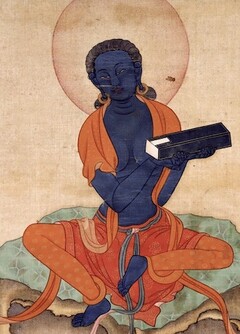Method for Reciting Zangchö Mönlam
English | Deutsch | Español | བོད་ཡིག
Translator's Introduction
Samantabhadra’s Aspiration to Good Actions (Zangchö Mönlam) from the Gaṇḍavyūha chapter of the vast Avataṃsaka Sūtra is one of the most popular and commonly recited prayers in Tibetan Buddhism. It is included in the Dhāraṇī section of the Kangyur (Toh 1095) and the Miscellaneous section of the Tengyur (Toh 4377). For those wishing to recite the prayer, Jamyang Khyentse Chökyi Lodrö composed some additional lines for the beginning and conclusion: verses for taking refuge, generating bodhicitta, visualizing the field of merit as witnesses to the prayer, and dedicating the merit.
Version: 1.0-20250519
༄༅། །བཟང་སྤྱོད་འདོན་ཐབས་ཉུང་ངུ་བཞུགས་སོ། །
A Brief Method for Reciting Samantabhadra's Prayer of Good Actions
by Jamyang Khyentse Chökyi Lodrö
སངས་རྒྱས་ཆོས་ཚོགས་སོགས་སྐྱབས་སེམས་ལན་གསུམ།
Recite ‘Sangye chötsok... etc.’ to take refuge and generate bodhicitta three times:
སངས་རྒྱས་ཆོས་དང་ཚོགས་ཀྱི་མཆོག་རྣམས་ལ། །
sangye chö dang tsok kyi chok nam la
In the Buddha, the Dharma and the Supreme Assembly
བྱང་ཆུབ་བར་དུ་བདག་ནི་སྐྱབས་སུ་མཆི། །
changchub bardu dak ni kyab su chi
I take refuge until I attain enlightenment.
བདག་གི་སྦྱིན་སོགས་བགྱིས་པའི་བསོད་ནམས་ཀྱིས། །
dak gi jin sok gyipé sönam kyi
Through the merit of practising generosity and so on,
འགྲོ་ལ་ཕན་ཕྱིར་སངས་རྒྱས་འགྲུབ་པར་ཤོག །
dro la pen chir sangye drubpar shok
May I attain buddhahood for the benefit of all beings.
མདུན་མཁར་བླ་མ་བཅོམ་ལྡན་ཤཱཀྱ་ཐུབ། །
dün khar lama chomden shakya tub
In the sky before me is the guru, the conqueror Śākyamuni,
མདུན་དུ་བྱང་ཆུབ་སེམས་དཔའ་ཀུན་ཏུ་བཟང་། །
dündu changchub sempa kuntuzang
And in front of him is the bodhisattva Samantabhadra,
ཕྱོགས་མཚམས་སྟེང་འོག་སངས་རྒྱས་བྱང་སེམས་སོགས། །
choktsam tengok sangye changsem sok
In the cardinal and intermediate directions, above and below, are the buddhas and bodhisattvas, and the rest,
སྨོན་ལམ་འགྲུབ་པའི་དཔང་པོར་བཞུགས་པ་དང་། །
mönlam drubpé pangpor zhukpa dang
Who remain as witnesses to the fulfilment of these aspirations,
མཐུན་འགྱུར་བདེན་ཚིག་གནང་བས་སྨོན་པའི་གནས། །
tün gyur dentsik nangwé mönpé né
And declare facilitating words of truth, through which the objects of my aspiration
ཇི་ལྟར་བཏབ་པ་ཡིད་བཞིན་འགྲུབ་པ་དང་། །
jitar tabpa yizhin drubpa dang
May be accomplished just as I wish for and request,
བྱང་ཆུབ་སྤྱོད་མཆོག་ཡོངས་སུ་རྫོགས་གྱུར་ནས། །
changchub chö chok yongsu dzok gyur né
And so that having entirely perfected supreme enlightened action,
ཀུན་ཏུ་བཟང་པོའི་སྨོན་ལམ་མཐར་ཕྱིན་ཤོག །
kuntuzangpö mönlam tarchin shok
I may bring the aspirations of Samantabhadra to complete fulfilment.
ཅེས་བརྗོད་ལ། གསལ་དག་སྙན་གསུམ་གྱིས་བཟང་སྤྱོད་བཏོན། མཐར།
Recite this, then chant the Prayer of Good Actions clearly, correctly and melodiously. At the end:
ཐུབ་དབང་འཁོར་བཅས་འོད་ཞུ་རང་ལ་ཐིམ། །
tubwang khor ché ö zhu rang la tim
Śākyamuni and his retinue melt into light and dissolve into me.
འོད་གསལ་སྤྲོས་པ་བྲལ་བའི་ངང་ལ་བཞགས། །
ösal tröpa dralwé ngang la zhak
I rest in a state of clear light, free from conceptual elaboration.
ཅེས་པའང་དཀར་མོའི་སྒྲུབ་བླ་ངག་ཆོས་ནས་བསྐུལ་ངོར། ཆོས་ཀྱི་བློ་གྲོས་པས་བྲིས་པའོ།། །།
In response to a request from Lama Ngakchö, the retreat master of Karmo,1 this was written by Chökyi Lodrö.
| Translated by Adam Pearcey with the generous support of the Khyentse Foundation and Tertön Sogyal Trust, 2020.
Source:
’Jam dbyangs chos kyi blo gros. "bzang spyod 'don thabs nyung ngu/" in ’Jam dbyangs chos kyi blo gros kyi gsung ’bum. 12 vols. Bir: Khyentse Labrang, 2012. W1KG12986 Vol. 7: 611
Version: 1.2-20241014
- ↑ i.e., Rongme Karmo Taktsang, a hermitage to the northeast of Dzongsar Monastery.
